Exhibition Kamil Lhoták
Exhibition opening: January 20 2025, 10 a.m. Exhibition closing: February 14 2025, 6 p.m.
Kamil Lhoták Exhibition | KODL Gallery Premises
Monday to Friday from 10 am to 6 pm.
Guided tours will be held with the exhibition curator, Libor Šteffek, at 4 pm on 23rd January, 29th January, 2nd February, and 13th February 2025.
Kamil Lhoták (1912–1990) was undoubtedly one of the most popular and versatile Czech artists of the 20th century. Although he didn't undergo an academic education, art became part of his life from a young age. Visiting exhibitions of various artists with his mother, who was very close to fine arts, significantly influenced his thoughts on his future career. Whilst studying at grammar school, his talent began to manifest itself, and at the end of the 1930s, he decided to become a professional artist.
From the beginning of his career, Kamil Lhoták was fascinated by the long-gone period of the late 19th and early 20th centuries, which he often reflected in his artwork. In his works, we can find a remarkable combination of nostalgia, longing, and stories that took place long ago in times preceding his childhood. His expression in painting, drawing and later graphics gave seemingly uninteresting places and old industrial objects a unique poetic impression, which he sought in places where most people saw nothing but abandoned and disposable articles of daily use.
At the end of 1942, a wider group of artists formed, united by several fundamental features expressed by the slogan “The World We Live In”. The group, soon named Group 42, tried to depict everyday life associated with man and the urban environment. This naturally had an impact on Lhoták’s work. Gliders and aircraft started to appear in his works, and empty corners and streets were supplemented with machines, pumps, windmills, and other technical objects. Even so, his works retained their poetics, and Lhoták was soon after described as a pioneer and representative of lyrical civilism.
In addition to Lhoták’s deep interest in technical inventions, another topic emphasised in his lifework was France, especially Paris.
Since the mid-1950s, we can observe an inclination towards landscape in his work, as evident primarily in his paintings. However, Lhoták was not interested in a picturesque or idealised depiction of the landscape; in his case, it was always a landscape somehow impacted by man.
At the beginning of the 1960s, there was a noticeable transformation in Lhoták’s painting. His conception of the landscape, still in the spirit of depicting individual scenes and objects, changed significantly. He began to use a contrast of two different coloured surfaces with a clear horizon line. The sky, which had always played a significant role in his paintings, depicted in a combination of white and blue, was now much more often separated by contrast from the terrestrial relief, captured in a rich green colour. This concept, expressed in his painting Green Ireland, can be found regularly in many variations in his works from this moment until the early 1970s.
The artist saw the surrounding landscape in an unconventional and, at the same time, realistic and poetic way. The unique and special concept and balance of painting combined with the magical depiction of reality were called magical realism, the second term closely linked to Lhoták after the aforementioned lyrical civilism.
Along with working with a larger surface, new motifs gradually transferred to Lhoták’s compositions - targets, “desert machines”, dragons, tents, and other typical artefacts bearing new dynamics began to appear in his works. These motifs played a dominant role in the next decade. From the mid-1970s, we can notice another change in his style. Lhoták strove more than ever for a distinctly expressive, strongly colouristic impact using various tools. The 1980s, the last decade of his life, were years of introspection and refining previous themes due to health limitations.
The exhibition presents a long period of several decades of Kamil Lhotáks’s life and work. Visitors will learn about the artist’s development and individual work stages through almost seventy works from private collections. Libor Šteffek, the author of several publications and other documents about Kamil Lhoták, curates the exhibition. The latest monographs, Kamil Lhoták – A Thousand Paintings and Kamil Lhoták – Graphics and Works on Paper, will also be available on-site. The exhibition is partly for sale.

Kamil Lhoták, Cycling Circuit (Alcyon), 1948

Kamil Lhoták, Baloon over the Landscape, 1941

Kamil Lhoták, Santos Dumont, 1940

Kamil Lhoták, Wincharger, 1942

Kamil Lhoták, A Park in Paris II., 1947

Kamil Lhoták, Green Ireland, 1970







